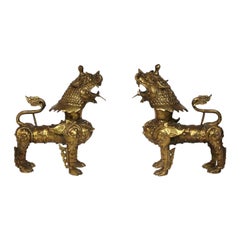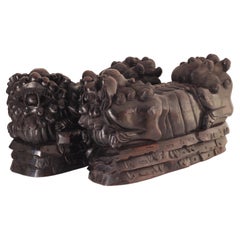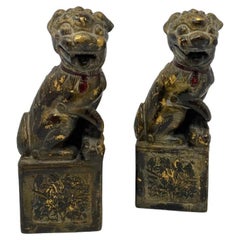1940s More Asian Art, Objects and Furniture
Period: 1940s
Color: Gold
Asian Bronze Foo Dogs
Located in Atlanta, GA
Pair of Asian Bronze Foo Dogs or Kylin Dragon, probably Tibetan, circa 1940s or earlier. They retain their warm original patina. These were purchased f...
Category
Tibetan Chinoiserie Vintage 1940s More Asian Art, Objects and Furniture
Materials
Bronze
Related Items
A pair of 19th Century carved Foo temple dogs or Chinese guardian Lions
Located in London, GB
Chinese guardian lions, or imperial guardian lions, are a traditional Chinese architectural ornament. Typically made of stone, they are also known as stone lions or shishi (石獅; shíshī). They are known in colloquial English as lion dogs or foo dogs / fu dogs. The concept, which originated and became popular in Chinese Buddhism, features a pair of highly stylized lions—often one male with a ball and one female with a cub—which were thought to protect the building from harmful spiritual influences and harmful people that might be a threat. Used in imperial Chinese palaces and tombs, the lions subsequently spread to other parts of Asia including Japan (see komainu), Korea, Philippines, Tibet, Thailand, Myanmar, Vietnam, Sri Lanka, Nepal, Cambodia, Laos, and Malaysia.
There has been extensive interaction between Chinese mythology and Confucianism, Taoism, and Buddhism. Elements of pre-Han dynasty mythology such as those in Classic of Mountains and Seas were adapted into these belief systems as they developed (in the case of Taoism), or were assimilated into Chinese culture (in the case of Buddhism). Elements from the teachings and beliefs of these systems became incorporated into Chinese mythology. For example, the Taoist belief of a spiritual Paradise became incorporated into mythology as the place where immortals and deities used to dwell. Sometimes mythological and religious ideas have become widespread across China's many regions and diverse ethnic societies. In other cases, beliefs are more limited to certain social groups, for example, the veneration of white stones by the Qiang. One mythological theme that has a long history and many variations involves a shamanic world view, for example in the cases of Mongolian shamanism among the Mongols, Hmong shamanism among the Miao people, and the shamanic beliefs of the Qing dynasty from 1643 to 1912, derived from the Manchus. Politically, mythology was often used to legitimize the dynasties of China, with the founding house of a dynasty claiming a divine descent.
Mythology and philosophy.
Further information: Chinese philosophy
True mythology is distinguished from philosophical treatises and theories. Elaborations on the Wu Xing are not really part of mythology, although belief in five elements could appear. The Hundred Schools of Thought is a phrase suggesting the diversity of philosophical thought that developed during the Warring States of China. Then, and subsequently, philosophical movements had a complicated relationship with mythology. However, as far as they influence or are influenced by mythology, divides the philosophical camps into two rough halves, a Liberal group and a Conservative group. The liberal group being associated with the idea of individuality and change, for example as seen in the mythology of divination in China, such as the mythology of the dragon horse that delivered the eight bagua diagrams to Fu Xi, and methods of individual empowerment as seen in the Yi Jing (Book of Changes). The Liberal tendency is towards individual freedom, Daoism, and Nature. The relationship of the Conservative philosophies to mythology is seen in the legendary Nine Tripod Cauldrons, mythology about the emperors and central bureaucratic governance, Confucianism, written histories, ceremonial observances, subordination of the individual to the social groups of family and state, and a fixation on stability and enduring institutions. The distinction between the Liberal and Conservative is very general, but important in Chinese thought. Contradictions can be found in the details, however these are often traditional, such as the embrace by Confucius of the philosophical aspects of the Yi Jing, and the back-and-forth about the Mandate of Heaven wherein one dynasty ends and another begins based according to accounts (some of heavily mythological) where the Way of Heaven results in change, but then a new ethical stable dynasty becomes established. Examples of this include the stories of Yi Yin, Tang of Shang and Jie of Xia or the similar fantastic stories around Duke of Zhou and King Zhou of Shang.
Mythology exists in relationship with other aspects of society and culture, such as ritual. Various rituals are explained by mythology. For example, the ritual burning of mortuary banknotes (Hell Money), lighting fireworks, and so on.
A good example of the relationship of Chinese mythology and ritual is the Yubu, also known as the Steps or Paces of Yu. During the course of his activities in controlling the Great Flood, Yu was supposed to have so fatigued himself that he lost all the hair from his legs and developed a serious limp. Daoist practitioners sometimes incorporate a curiously choreographed pedal locomotion into various rituals. Mythology and practice, one explains the other: in these rituals, the sacred time of Yu merges with the sacral practice of the present.
Various ideas about the nature of the earth, the universe, and their relationship to each other have historically existed as either a background or a focus of mythologies. One typical view is of a square earth separated from a round sky by sky pillars (mountains, trees, or undefined). Above the sky is the realm of Heaven, often viewed of as a vast area, with many inhabitants. Often the heavenly inhabitants are thought to be of an "as above so below" nature, their lives and social arrangements being parallel to those on earth, with a hierarchical government run by a supreme emperor, many palaces and lesser dwellings, a vast bureaucracy of many functions, clerks, guards, and servants. Below was a vast under ground land, also known as Diyu, Yellow Springs, Hell, and other terms. As time progressed, the idea of an underground land in which the souls of the departed were punished for their misdeeds during life became explicit, related to developments in Daoism and Buddhism. The underground world also came to be conceived of as inhabited by a vast bureaucracy, with kings, judges, torturers, conductors of souls, minor bureaucrats, recording secretaries, similar to the structure of society in the Middle Kingdom (earthly China).
Chinese temple Dogs...
Category
Chinese Chinese Export Antique 1940s More Asian Art, Objects and Furniture
Materials
Hardwood
H 11.42 in W 20.48 in D 7.49 in
Vintage 1970s Neiman Marcus Japan Bronze Foo Dogs
Located in San Diego, CA
Incredibly beautiful pair of 1970s vintage bronze foo dogs by Neiman Marcus Japan. Guardian lions, also known as komainu, shishi, or foo dogs, are intimidating, mythical, lion-like c...
Category
Japanese Chinoiserie Vintage 1940s More Asian Art, Objects and Furniture
Materials
Bronze
Pair of Patinated Bronze Chinese Foo Dogs
Located in San Diego, CA
Pair of patinated bronze Chinese foo dogs, circa 1950s. The pair are in good vintage condition with amazing detail and a gorgeous patina. Each dog measures 4"W x 3"D x 3.5"H #3295
Category
Chinese 1940s More Asian Art, Objects and Furniture
Materials
Bronze
Antique Asian Chinese Horn Dragons Head Victorian Vintage Walking Stick Cane
Located in Dublin, Ireland
Very Unusual Horn Sectional Hand Carved Chinese Walking Stick or Dress Cane of outstanding quality, last half of the Nineteenth Century.
The ...
Category
Chinese Victorian Antique 1940s More Asian Art, Objects and Furniture
Materials
Sterling Silver
Pair of Small Patinated Bronze Chinese Foo Dogs
Located in San Diego, CA
Pair of small patinated bronze Chinese foo dogs, circa 1950s. Excellent vintage condition with amazing detail and a gorgeous patina. Each dog measures 4.25" high x 2.5" deep x 3.5" w...
Category
Chinese 1940s More Asian Art, Objects and Furniture
Materials
Bronze
Antique Monumental Asian Hand-Carved Wooden Decorative Panel
Located in North Hollywood, CA
Antique Asian Thai monumental, measuring 8’ x 8' hand-carved wooden temple panel.
Definitely a one of a kind piece Thai red and gold panel with de...
Category
Thai Folk Art 1940s More Asian Art, Objects and Furniture
Materials
Wood
Pair of Patinated Bronze Chinese Foo Dogs
Located in San Diego, CA
Pair of patinated bronze Chinese foo dogs, circa 1930s. Excellent vintage condition with amazing detail and a gorgeous patina. Each dog measures 6.5" high x 3.5" deep x 4.75" wide. #...
Category
Chinese 1940s More Asian Art, Objects and Furniture
Materials
Bronze
Vintage Asian Glazed Ceramic Foo Dogs - a Pair
Located in west palm beach, FL
A fabulous pair of vintage Asian foo dogs. A chic glazed ceramic in bright clear colors. Two expressions add to the charm. Acquired from a Palm Beach estate.
Category
Japanese 1940s More Asian Art, Objects and Furniture
Materials
Ceramic
Pair vintage Teal Foo Dogs Hollywood Regency Chinoiserie
Located in West Palm Beach, FL
Lovely pair of vintage teal green blue foo dogs. No chips or breaks.
Category
Chinoiserie Vintage 1940s More Asian Art, Objects and Furniture
Pair of Patinated Bronze Chinese Foo Dogs / Book Ends
Located in San Diego, CA
Impressive pair of patinated bronze Chinese foo dogs / book ends, circa 1930s. Excellent vintage condition with amazing detail and a gorgeous patina. Each dog measures 6.5" high x 3....
Category
Chinese 1940s More Asian Art, Objects and Furniture
Materials
Bronze
Large Bronze Buddha Head with Stand Thailand
Located in Atlanta, GA
A impressive bronze Buddha head fragment displayed on wood stand circa late 19th century. The Buddha was cast in the early "U Thong" style that flourished between the 12-13rd century A.D in Central Thailand. The Buddha iconography of that period is exemplified by the influence from Mon and Khmer kingdom, featuring a more square face and a characteristic small band between the hairline and the forehead.
This large Buddha head...
Category
Thai Other Antique 1940s More Asian Art, Objects and Furniture
Materials
Bronze
Antique bronze Opiumweight from Burma
Located in DEVENTER, NL
Material: bronze
5 cm high
3,9 cm wide and 4 cm deep
Weight: 0.159 kgs
Originating from Burma
18th century
Category
Burmese Antique 1940s More Asian Art, Objects and Furniture
Materials
Bronze
Recently Viewed
View AllMore Ways To Browse
Antique Tibetan Coral Beads
Antique Chinese Lunch Box
Jain Marble
Jomon Period
Chinese Hair Comb
Tibet Drum
Edo Chair
Vintage Bonsai Pots
Chinese Handled Lunch Box
Vintage Bonsai Pot
Asian Lunch Box
Saga Pottery
Glass Overlay Chinese Snuff Bottle
Hand Carved White Jade Buddha
Conch Trumpet
Burmese Terracotta
Trumpet Conch
Walking Buddha


